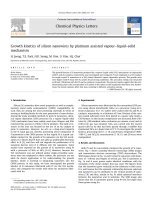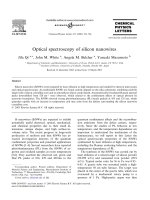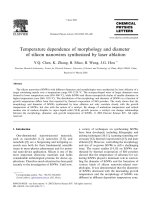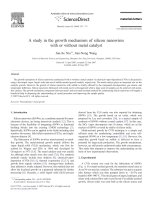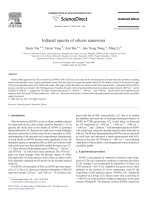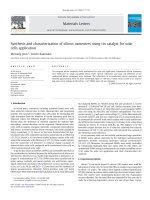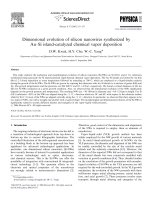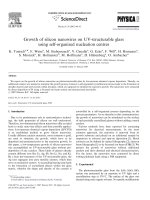laser direct write of silicon nanowires
Bạn đang xem bản rút gọn của tài liệu. Xem và tải ngay bản đầy đủ của tài liệu tại đây (1.15 MB, 6 trang )
Laser direct write of silicon nanowires
James I. Mitchell
Se Jun Park
C. Adam Watson
Pornsak Srisungsitthisunti
Chookiat Tansaraw iput
Minghao Qi
Eric A. Stach
Chen Yang
Xianfan Xu
Optical Engineering 50(10), 104301 (October 2011)
Laser direct write of silicon nanowires
James I. Mitchell
Se Jun Park
C. Adam Watson
Pornsak Srisungsitthisunti
Purdue University
Birck Nanotechnology Center
School of Mechanical Engineering
1205 W State Street
West Lafayette, Indiana 47907
Chookiat Tansarawiput
Minghao Qi
Purdue University
Birck Nanotechnology Center
School of Electrical and Computer Engineering
1205 W State Street
West Lafayette, Indiana 47907
Eric A. Stach
Purdue University
Birck Nanotechnology Center
School of Materials Science Engineering
1205 W State Street
West Lafayette, Indiana 47907
Chen Yang
Purdue University
Birck Nanotechnology Center
School of Chemistry
1205 W State Street
West Lafayette, Indiana 47907
Xianfan Xu
Purdue University
Birck Nanotechnology Center
School of Mechanical Engineering, and School of
Electrical and Computer Engineering
1205 W State Street
West Lafayette, Indiana 47907
E-mail:
Abstract. Using laser direct writing in combination with chemical vapor
deposition to produce nanometer scale electronics holds several advan-
tages over current large scale photolithography methods. These include
single step electrical interconnect deposition, mask-less patterning, and
parallel processing. When taken together they make quick production
of individualized electronic circuits possible. This work demonstrates the
ability of combining laser direct write and chemical vapor deposition to pro-
duce silicon wires a few hundred nanometers wide. Optimized parameters
will be discussed, with a particular emphasis paid to the laser-material
interactions. The feasibility for electronic applications will be shown by
examining the deposition formation on a silicon dioxide surface without
degrading the surface’s integrity, and by evaluating the resistivity of the
deposited silicon wires.
C
2011 Society of Photo-Optical Instrumentation Engineers
(SPIE)
. [DOI: 10.1117/1.3630225]
Subject terms: laser applications; deposition; femtosecond phenomena; focal plane
arrays.
Paper 110675R received Jun. 15, 2011; revised manuscript received Aug. 1, 2011;
accepted for publication Aug. 8, 2011; published online Sep. 29, 2011.
1 Introduction
For decades, photolithography has been the predominant
method of silicon circuit fabrication due to its high through-
put and ability to produce feature sizes on the order of tens
of nanometers. However, its drawbacks include expensive
masks, multiple coating, etching, and developing steps, and
photoresist restrictions. Laser-based manufacturing technol-
ogy, on the other hand, can circumvent some of these lim-
iting obstacles. Laser direct write has been demonstrated
for various microfabrication and nanoscale patterning ap-
plications. Examples include the use of near-field scanning
optical microscopy to achieve line sizes on the order of
tens of nanometers,
1
near-field parallel lithography which
0091-3286/2011/$25.00
C
2011 SPIE
can produce tens of nanometer features in parallel,
2
three-
dimensional polymerization of sub-micron features using
femtosecond laser pulses,
3–5
and forward transfer of ma-
terials from a sacrificial mask to a substrate surface to form
dots hundreds of nanometers in width.
6, 7
The feasibility of
laser deposition for repairing a lithographic mask,
8
bridg-
ing broken circuits,
9, 10
and making transistors, capacitors,
resistors, photonic bandgap structures and other electrical
components,
11, 12
has also been demonstrated.
In this work, we combine laser direct write and chemi-
cal vapor deposition (CVD) methods, with an intention to
produce feature sizes of hundreds of nanometers. We will
describe the laser direct write CVD experimental methodol-
ogy used to produce semiconductor nanowires, the parame-
ter optimization for controlling the heat distribution, and an
evaluation on the feasibility for electronic applications.
Optical Engineering October 2011/Vol. 50(10)104301-1
Mitchell et al.: Laser direct write of silicon nanowires
Input
Laser
Window
SiH
4
, N
2
Gas Nozzle
Piezoelectric
XYZ stage
Zone
Plates
Substrate
CVD
Chamber
Fig. 1 Schematic diagram of the system for laser direct writing of
silicon nanowires.
2 Experimental Details
In the laser direct write CVD system, the laser energy is ap-
plied to the surface of a substrate material in a vacuum cham-
ber and creates a localized heating area. Reactive gas (silane
for silicon growth) is delivered to this locally heated area
and therefore decomposes, leaving behind a small amount
of material deposited on the surface. While the material is
being deposited, the piezoelectric stage holding the substrate
moves relative to the focused laser spot, making the conduc-
tive lines into the desired pattern. A schematic illustrating
the experimental setup is shown in Fig. 1.
In our work for producing silicon nanowires, deposition
was performed at a pressure between 10 and 15 Torr with a
constant flow rate of 5 sccm of 10% silane in argon. Continu-
ous wave (cw) and femtosecond (fs) laser systems were tested
to compare the results. The cw laser used was a ND:yttrium–
aluminum–garnet laser with a wavelength of 532 nm and
a maximum power of 10 W. The femtosecond laser used
was a mode-locked Ti:sapphire laser with a wavelength of
800 nm, about 100 fs pulse duration, 14 nJ per pulse max-
imum, and a repetition rate of 86 MHz. The femtosecond
laser output was then frequency-doubled to 400 nm using a
0.5-mm thick barium borate (BBO) crystal and then focused
onto the substrate surface with high numerical aperture Fres-
nel phase zone plates. These phase zone plates are made from
hydrogen silsesquioxane (HSQ) coated on a quartz substrate
and patterned by electron beam lithography (EBL). Indium
tin oxide (ITO) is coated on the quartz substrate to avoid
charging during EBL, and a hexamethyldisilazane (HMDS)
layer is used to improve the adhesion of the developed HSQ
to the ITO. In order to produce nanoscale structures, a small
laser spot is desirable. The size of the spot produced by the
zone plate is calculated as
13
w
o
=
0.61λ
n sin
[
arctan(D/2 f )
]
, (1)
where w
o
is the spot size, λ is the wavelength, n is the index
of refraction, D is the diameter of the zone plate, and f is the
focal length. Using the typical zone plate diameter and focal
length of 300 and 50 μm, respectively, the diffraction-limited
spot sizes become 0.342 μm for 532 nm light and 0.257 μm
for 400 nm light.
Since the sample substrate must be positioned at the
zone plate focal point, it is important to know the depth
of focus (DOF) of the zone plate, which is computed
as:
13
DOF = 0.64
πw
2
o
λ
. (2)
For the zone plates used in this work, the depth of focus
is 0.332 and 0.442 μm for 400 and 532 nm wavelength, re-
spectively. The gap distance between the zone plate and the
substrate therefore needs to be very well controlled. In this
work, an interferrometric spatial phase imaging (ISPI)
14
tech-
nique was used to detect the gap distance between the zone
plate and the substrate, and then a five-axis high precision
piezoelectric nanopositioning stage was employed to adjust
and maintain the desired distance. ISPI is an alignment tech-
nique with nanometer resolution developed by Moon et al.
14
In our case, the sensitivity achieved is on the order of tens
of nanometers, which is sufficient to give accurate readings
for the gap distance between the zone plate and the substrate.
The piezoelectric nanopositioning stage has a resolution of
better than 1 nm and the overall noise of the system is less
than 15 nm. Therefore, the combination of these components
yields more than adequate control for the required precision.
Two different substrates were used in our work. The first
was 1-mm thick quartz with a 200 nm polysilicon top layer.
The second substrate was the same as the first substrate with
an additional deposition of 50 nm of silicon dioxide on top of
the quartz and polysilicon. Quartz was chosen to minimize
the heat conducted away from the area directly under the
incident laser while the thin polysiliconlayer acted as a means
for absorbing laser radiation. The topmost silicon dioxide
layer in the second substrate acted to electrically insulate the
deposited lines from the polysilicon for potential electronic
applications.
3 Results and Discussion
Silicon wires with fully controlled lengths up to 200 μm
(limited by the scan range of the piezoelectric stage) on both
substrates have been fabricated using either cw or fs lasers.
Fig. 2 SEM images of (a) cw laser deposited silicon line on polysili-
con with a linewidth of around 600 nm. (b) cw laser deposited silicon
line on silicon dioxide with a linewidth around 1.2 μm. (c) fs laser
deposited silicon line on silicon dioxide with a linewidth of around
300 nm. (d) fs laser deposited silicon line on polysilicon with a width
of around 500 nm.
Optical Engineering October 2011/Vol. 50(10)104301-2
Mitchell et al.: Laser direct write of silicon nanowires
Fig. 3 SEM image of femtosecond laser deposited silicon line with
(a) horizontally polarized light, (b) vertically polarized light, (c) 45 deg
polarized light, and (d) circularly polarized light. For all images the
substrate is 200 nm of polysilicon on 1 mm of quartz.
For nanowires deposited using the cw laser on the substrate
of polysilicon on quartz, t he minimum linewidth is around
600 nm [Fig. 2(a)]. This linewidth is slightly larger than
the diffraction-limited spot size of 0.442 μm due to heat
diffusion. When tested on the substrate with a silicon dioxide
top layer, the minimum linewidth was in excess of 1 μm
[Fig. 2(b)]. This larger linewidth is also due to heat diffusion
since the heat absorbed by the polysilicon diffuses more in
the lateral direction before it reaches the surface. Conversely,
for the fs laser deposition, the narrowest lines were around
300 nm as seen in Fig. 2(c), on the substrate with the
silicon dioxide top layer. When the fs laser was tested on
polysilicon on quartz, the minimum line width was around
500 nm as shown in Fig. 2(d). The surface of the nanowires
produced is generally rough, which may be beneficial for
applications such as chemical sensing where a large surface
area is desirable.
The substrate characteristics play a key role in under-
standing and optimizing the deposition formation. The most
important substrate qualities are the absorptivity and ther-
mal diffusivity. For the substrate of polysilicon on quartz,
the thickness of the polysilicon layer is adequate for absorb-
ing both the 532 nm cw laser and the 400 nm fs laser. The
linewidth produced by the cw laser is larger than that pro-
duced by the fs laser due to the longer heat diffusion lengths
produced by a cw laser. For the substrate with a silicon diox-
ide top layer, there is a difference between the absorption of
the two types of lasers. For the fs laser, the top silicon dioxide
layer absorbs laser energy,
3
whereas the silicon dioxide does
not absorb energy from the cw laser. Ultrafast laser pulses
incident on wide bandgap materials can create a multipho-
ton absorption effect, causing absorption in materials that
would otherwise be transparent. This multiphoton absorp-
tion decreases the laser absorption area and can reduce the
fabricated feature size,
3, 15
which explains why the deposited
silicon on silicon dioxide is narrower compared with that on
polysilicon.
Various experimental parameters were tested to explore
the minimum linewidth, the measure for the resolution of
the laser writing method. Minimizing the laser intensity was
proven to be critical for minimizing the linewidth. The Gaus-
sian shape of the laser beam allows only the most intense
portions at the center of the profile to be absorbed, which re-
duces the size of the heated area and the linewidth produced.
This further explains why for the case using a fs laser, the
Deposited
platinum for
TEM imaging
Sputtered carbon
for higher FIB
conductivity
CW direct
write LCVD
line
Native Oxide
Substrate
silicon layer for
absorption
Quartz
substrate
Fig. 4 Cross sectional TEM image of cw laser deposited silicon showing the substrate surface.
Optical Engineering October 2011/Vol. 50(10)104301-3
Mitchell et al.: Laser direct write of silicon nanowires
minimum linewidth can be even smaller than the laser spot
size. In contrast, the linewidth was relatively insensitive to
pressure, silane flow rate, and scan speed of the piezoelectric
stage. Pressures ranging from 1 to 25 Torr, silane flow rates
of between 1 and 20 sccm, and laser scan speeds from 0.1 to
5.0 μm/s were tested. Although they had some effect on the
width, these parameters were by no means heavily influential
in the linewidth. An alteration to flow rate, pressure, or scan
speed will cause changes in the amount of deposited material
(thickness of the nanowire), but the linewidth is less affected.
The polarization of the laser beam also affects the
morphology of the deposited lines, similar to the formation
of laser induced polarization surface structures (LIPSS) re-
ported in the literature.
16
These LIPSS form perpendicular to
the incident electric field, and for our laser direct write CVD
process they make undesirable ridges which can degrade
the line continuity. Figures 3(a)–3(c) show the relationship
between the polarization direction and the deposition
continuity. The ridges are all formed perpendicular to the
laser polarization direction. To circumvent this drawback the
laser was circularly polarized using a quarter wave plate, and
subsequently the ridges were almost completely removed as
shown in Fig. 3(d).
For this laser direct write CVD technique to be consid-
ered a legitimate method for creating a device, the fabrication
process must not degrade the surface integrity and the lines
that are created must have a functional resistivity. The trans-
mission electron microscopy (TEM) image in Fig. 4 shows
that the silicon dioxide surface directly under the deposi-
tion remains completely intact after deposition, demonstrat-
ing that this can be done without destroying the top layer
or ablating the substrate surface. The electrical conductivi-
ties of t hese laser direct written wires were obtained by first
fabricating metal contacts directly on as-written wires on sil-
icon dioxide substrates, followed by current–voltage (I–V)
measurements. The I–V measurements were carried out for
various wire lengths deposited on silicon dioxide. A linear
curve fit was then used to find the resistivity of the polysil-
icon wires, which was estimated to be 2×10
5
· cm. This
value is consistent with the value of undoped polysilicon
(4.5×10
5
· cm),
17
indicating that it is foreseeable to use
these lines for device fabrication. Controlled in situ doping
is currently being carried out to fabricate functional devices
such as chemical sensors.
4 Conclusions
Laser direct write CVD is shown to be capable of producing
feature sizes on the scale of a few hundred nanometers. It was
found that the narrowest linewidth was produced using an fs
pulsed laser on a silicon dioxide surface, due to multipho-
ton absorption in silicon dioxide and confined heating by fs
pulses. There is minimal damage to the substrate surface after
deposition, and the deposited lines have the necessary elec-
tronic properties for successful integration into an electronic
device.
Acknowledgments
Support for this work by the Defense Advanced Research
Project Agency (Grant No. N66001-08-1-2037), Program
Managers Dr. Thomas Kenny and Dr. Tayo Akinwande, and
the National Science Foundation is gratefully acknowledged.
The authors also thank Dr. E.E. Moon for help in setting up
ISPI.
References
1. D. Hwang, S. G. Ryu, N. Misra, H. Jeon, and C. P. Grigoropoulos ,
“Nanoscale laser processing and diagnostics,” Appl. Phys. A 96, 289–
306 (2009).
2. S. M. V. Uppuluri, E. Kinzel, Y. Li, and X. Xu, “Parallel optical nano-
lithography using nanoscale bowtie aperture array,” Opt. Express 18(7),
7369–7375 (2010).
3. J. Koch, F. Korte, C. Fallnich, A. Ostendorf, and B. N. Chichkov,
“Direct-write subwavelength structuring with femtosecond laser
pulses,” Opt. Eng. 44(5), 051103 (2005).
4. F. Korte, J. Serbin, J. Koch, A. Egbert, C. Fallnich, A. Ostendorf, and
B. N. Chichkov, “Towards nanostructuring with femtosecond laser
pulses,” Appl. Phys A 77, 229–235 (2003).
5. H. Schuck, D. Sauer, T. Anhut, I. Reimann, and K. Konig,
“Sub-100 nm nanostructuring of silicon by ultrashort laser pulses,”
Opt. Express 13(17), 6651–6656 (2005).
6. D. P. Banks, C. Grivas, J. D. Mills, R. W. Eason, and I. Zergioti, “Nan-
odroplets deposited in microarrays by femtosecond Ti:sapphire laser-
induced forward transfer,” Appl. Phys. Lett. 89, 193107 (2007).
7. C. B. Arnold, P. Serra, and A. Pique, “Laser direct-write techniques for
printing of complex materials,” Mater. Res. Soc. Symp. Proc. 32, 23–31
(2007).
8. D. Bauerle, Laser Processing and Chemistry, Springer-Verlag, Berlin
Heidelberg (1996).
9. T. H. Baum and P. B. Comita, “Laser-induced chemical vapor deposition
of metals for microelectronics technology,” Thin Solid Films 218, 80–94
(1992).
10. J.B.Park,C.J.Kim,P.E.Shin,S.H.Park,H.S.Kang,andS.H.
Jeong, “Hybrid LCDV of micro-metallic lines for TFT-LCD circuit
repair,” Appl. Surf. Sci. 253, 1029–1035 (2006).
11. E. C. Kinzel, H. H. Sigmarsson, X. Xu, and W. J. Chappell, “Laser
sintering of thick-film conductors for microelectronic applications,”,
J. Appl. Phys. 101, 063106 (2007).
12. M. C. Wanke, O. Lehmann, K. Muller, Q. Wen, and M. Stuke, “Laser
rapid prototyping of photonic band gap microstructures,” Science
275(5304), 1284–1286 (1997).
13. F. L. Pedrotti, L. S. Pedrotti, and M. L. Perdotti, Introduction to Optics,
pp. 316, Pearson Education Inc., San Fransisco, California (2007).
14. E. E. Moon, L. Chen, P. N. Everett, M. K. Mondol, and H. I. Smith,
“Interferometric-spatial-phase imaging for six-axis mask control,”
J. Vac. Sci. Technol. B 21(6), 3112–3115 (2003).
15. W. H. Teh, U. Durig, U. Drechsler, C. G. Smith, and H J. Guntherodt,
“Effect of low numerical-aperture femtosecond two-photon absorp-
tion on (SU-8) resist for ultrahigh-aspect-ratio microstereolithography,”
J. Appl. Phys. 97(5), 054907 (2005).
16. A. Borowiec and H. K. Haugen, “Subwavelength ripple formation on
the surfaces of compound semiconductors irradiated with femtosecond
laser pulses,” Appl. Phys. Lett. 82(25), 4462–4464 (2003).
17. T. I. Kamins, “Resistivity of chemically deposited polycrystalline-
silicon films,” Solid-State Electron. 15, 355–358 (1972).
James Mitchell is a PhD student in me-
chanical engineering at Purdue University.
He received his BS degree in mechanical
engineering from Brigham Young University
in 2007 and his MS degree from Purdue in
2010. He is currently engaged in research
on ultrafast laser manufacturing for electron-
ics and sensing applications using chemical
vapor deposition.
Se Jun Park received his BS degree in ce-
ramic engineering from Yonsei University,
Republic of Korea in 1996, and MS and
PhD degrees in materials science and en-
gineering from Yonsei University in 1998 and
2005. From 2005 to 2007, he worked as a
postdoctoral researcher in the Korea Insti-
tute of Science and Technology, and from
2007 to 2010, he worked as a postdoctoral
researcher at Purdue University. He currently
works for Samsung Electronics in Korea in
the field of thin film processing.
Optical Engineering October 2011/Vol. 50(10)104301-4
Mitchell et al.: Laser direct write of silicon nanowires
C. Adam Watson received his BS degree in
mechanical engineering from Purdue Univer-
sity in 2011. His interests are in sustainability,
renewable energy, and hybrid vehicle tech-
nologies. He is currently in a Sales Engineer
Training program with Schneider Electric.
Pornsak Srisungsitthisunti received his
BS degree in mechanical engineering from
University of Wisconsin–Madison in 2005.
He received his MS degree in mechanical
engineering from Purdue University, Indiana
in 2007, and is currently pursuing his PhD
in the same department. His research inter-
ests include ultrafast laser material process-
ing and near field optics.
Chookiat Tansarawiput is a PhD student in
electrical and computer engineering at Pur-
due University. His research interests are in
the field of nanostructure fabrication, self-
assembly nanowires, and solar cells.
Minghao Qi is an associate professor of
Electrical and Computer Engineering at Pur-
due University. He received his PhD in elec-
trical engineering from the Massachusetts
Institute of Technology in 2005. His current
research includes the design, fabrication,
and characterization of silicon photonic de-
vices, development of new lithographic tech-
niques for integrated-circuit patterns, and
low-cost manufacturing of silicon solar cells.
He received a Young Investigator Award from
the Defense Threat Reduction Agency. He is a member of Sigma Xi,
IEEE, MRS, and OSA.
Eric A. Stach leads the Electron Microscopy
Group in the Center for Functional Nanoma-
terials (CFN) at Brookhaven National Labo-
ratory. He received his PhD in materials sci-
ence and engineering from the University of
Virginia. He has held positions as staff sci-
entist and principal investigator at the Na-
tional Center for Electron Microscopy at the
Lawrence Berkeley National Laboratory and
as associate and then full professor at Pur-
due University, where he retains an Adjunct
appointment. His research interests focus on the development and
application of electron microscopy techniques to solve materials
problems in nanostructure growth, catalysis, thin film growth and ma-
terials deformation. He has received several awards, among them
the Microscopy Society of America’s Eli F. Burton (Young Scientist)
Award, and Purdue University’s Faculty Scholar and Early Career
Research Excellence Awards. He is the author of over 120 peer-
reviewed publications, and has given over 100 invited presentations
at conferences and university, corporate, and national laboratories.
Chen Yang is an assistant professor in the
Department of Chemistry and Department
of Physics at Purdue University. She re-
ceived her doctoral degree in Chemistry from
Harvard University. Her research interest is
focusing on nanomaterials for their potential
applications in nanoscale devices and bio-
logical applications. Her research has been
published in high profile journals, including
Science, Nature, Physics Review Letter, and
Nano Letters, and has been featured by pub-
lic press releases, including Chemical and Engineering News, and
Harvard Gazette magazine. She has won the NSF Career Award and
Purdue Seed of Success.
Xianfan Xu is the James J. and Carol
L. Shuttleworth professor of mechanical
engineering at Purdue University. He ob-
tained his PhD degree in mechanical en-
gineering from the University of California,
Berkeley in 1994. His research interests in-
clude fundamentals of ultrafast laser-matter
interaction, near-field nano-optics, laser-
based micro- and nano-engineering, and ul-
trafast diagnostics of energy transfer in nano-
materials including nanostructured energy
conversion materials. He is the recipient of the National Science
Foundation Faculty CAREER Award, the Office of Naval Research
Young Investigator Award, and the B.F.S. Schaefer Young Faculty
Scholar Award of Purdue University. He is a fellow of SPIE and a
fellow of the American Society of Mechanical Engineers.
Optical Engineering October 2011/Vol. 50(10)104301-5

